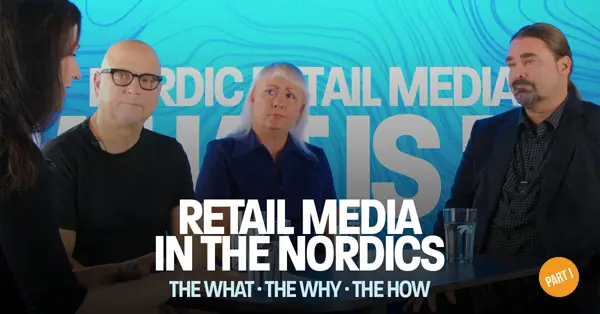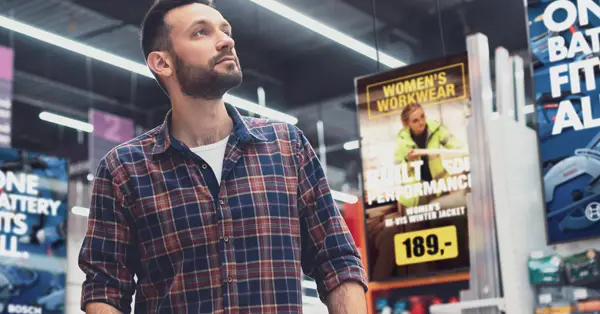This post is originally published in Doohlabs website: www.doohlabs.com
---
1. Be active in all business areas that suit your strategy
When building the in-store retail media network from scratch, a retailer often chooses one business model to get processes working and customers on board effectively. A natural way for a grocery retailer to start the in-store retail media business could for example be to organize media sales for brands via a media sales team –be it outsourced for a media sales partner or operated by retailer’s own newly organized team. The presented ads are then the in-store expression of advertisers omnichannel strategies.

Retail media can however be organized with several models. Besides the direct media sales to both endemic and non-endemic advertisers you can use the same platform for targeted advertising for your own in-house brands. The target then of course increasing the incremental sales and growing the total basket.
Another business model is more of a modern version of trade marketing. Retailers and trade marketers agree on the level of campaigning per brand for a fixed period. Brands want to get seen as near to the actual purchasing decision they can, and retailers can offer them the access.
The fourth business model is an extension of media sales – the programmatic. In in-store retail media, the role of programmatic is still marginal and we believe it’ll be that for a few years to come. There are many reasons for this. Business-wise, retailers aren’t that eager to share the profits with the platforms and technologically, programmatic platforms really are not too good in selling audiences in the physical world.
As programmatic media sales get bigger, we see its role as profit maximizer. Most of the audience inventory will be sold by the retailer or its partners, but to be as efficient as possible, the remining inventory can be offered to programmatic actors.
From retailer’s point-of-view, when scaling it is important to understand how the business environment looks in the next coming years and be technologically and organizationally ready to adapt new models when appropriate.
2. Expand screens to endcaps
First screens in stores tend to be installed in locations where they are thought to be best seen. These practices come from the world of digital out-of-home and the business logic is to reach as many eyeballs as you possibly can. The in-store retail media business logic is a bit different when optimal, though.

The endcaps traditionally have been a badly wanted location for brands in stores. Brands have fought about their time in the prime and for retailers it has been problematic that there is only a limited number of endcaps to offer for advertising purposes.
Only to have screens in end-caps, dramatically increases then number of advertisers that can get to these prime places. The endcap represents the best place to be seen for the brands in the shelfs near buy. And as you get as near the buying decision as possible, the odds your product gets selected increase substantially.
But it is not only the location that makes endcaps so remarkable in retail media. In in-store retail media, the customer insight the retailer has on buyers of each product category makes it easy to target the precise target group when they are best reached near the endcap. The impact of advertising gets very high.
In a typical supermarket not to mention a hypermarket, there are dozens of endcaps. When scaling up, these should be the first locations the retailer should consider spreading the network.
3. Choose the optimal financial model to scale up the network
Typically, the in-store networks have been financed with direct CAPEX. You calculate the needed investment, evaluate the time you think it will take for profits to cover it, and make the decision if and how to proceed.
But this is not the only available model, and it is for certain not the best for all companies in all situations. Another widely used model is to lease the needed hardware for the network. By leasing a retailer can spilt expenses for monthly bases and finance the network as it starts creating new ad revenue. The possible risk for the investment gets minimized.

A step further is a model built around the network lifecycle. In lease arrangements there still are some expenses and other things you need to take care of yourself as it concentrates on covering hardware investment. The lifecycle model agrees on a fixed price with full service for an agreed period and aims to cover every situation you may encounter during the years. The only thing you need to worry is how to grow your business and serve your advertisers the best way you can.
4. Standardize your screen & audio network
In relations but not limited to financing the network, is the question of the quality of your in-store network. By quality, we mean specifically the processes related to the hardware.

Especially in cases you are funding your network growth with CAPEX it is extremely important you pay attention in harmonizing the hardware and the processes that come with them. Each manufacturer has their own specific ways of working and rules for customer service. As your network service provider tries to keep up in pace with your business growth, not taking care that your fleet of equipment is harmonized may create very unpleasant surprises.
Multiple hardware providers can multiply the expenses you face in maintaining the network. With heterogenous hardware you are almost certainly also facing lower SLA’s and far more problems as the procedures of keeping them working cannot be uniform.
When leasing and especially when operating a lifecycle model, these problems get automatically minimized as the service provider naturally equally wants a harmonized operations as humanly possible.
5. Make automation the leading in principle in your platform development
We’ve talked a lot about this earlier but automation’s relevance for profitability just cannot be overstated. Automation is a key element for every in-store retail media network to operate in scale and to be able to cope with the growing demand from advertisers. Some automations are mandatory for in-store retail media, such as the ability to distribute the ads based on data to target groups at the right moment in right stores. But there are others that can make a great impact on profitability as well.
You see, in-store retail media while being a digital business happens in the real world, in physical stores. There are a lot of things you just cannot control. But the things you can do to automate & streamline your operations are the most important things you can do to help your in-store business to grow.
Automating content production is one of the important areas of automation. Content automation typically means connecting the in-store retail media network to your digital asset management system (DAM) and product information management (PIM) system. With this connection, your advertisers are able create most of the marketing materials (the tactical part of advertising) with minimum effort.

Another form of automation is enabled by integrating to your POS-system. Besides the obvious benefits of for example having all the prices updated all the time, POS-integration enables one of the key features of retail media: closed loop. The closed loop means that you are (automatically) able to report the success of advertising efforts as effects on sales to the advertisers. As advertisers can now see the real power of in-store advertising in sales figures, it is guaranteed to grow and continue making profits.
6. Do not scale personnel at the same pace the business scales up
The last one seems obvious as it is applicable to most growing businesses. It’s nonetheless a phenomenon we see far too often to happen. When the growth gains momentum as in retail media currently, it is only natural for retailers to respond by hiring more hands and brains to tackle things that get in their way in everyday business. But to control the profitability of the growth requires you to act on other fronts too.
Let me explain this with an example. As stated above, the automation is a key element in platform development and all automation also typically increases profitability when done right. One form of automation that lies in the very heart of retail media value creation and is a perfect example of building profitability is trade partner self-services.

Trade-partner self-service is a channel in which brands by themselves control the advertising in stores. The retailer agrees with a partner as part of their yearly agreements of the level of reach they need to have in near future. Trade partner gets its own audiences based on retailer’s insight and decides independently based on data in which stores and at what times will they want to reach their target groups. Ads are either created automatically from retailer systems or the trade partner traffics the needed marketing materials in the system and schedules the campaign. Campaign results and effects on sales are again of course reposted manually with possible expert analysis assistance provided by the retailer.
Retailers’ resources in this process are limited only to stages where most value is created: in creating audiences that provide best results for trade-partner advertising. When this same principle (Automate everything that can be automated and concentrate on serving the customer) is applied to all processes needed in in-store retail media, the profits and happy customers go hand in hand.







